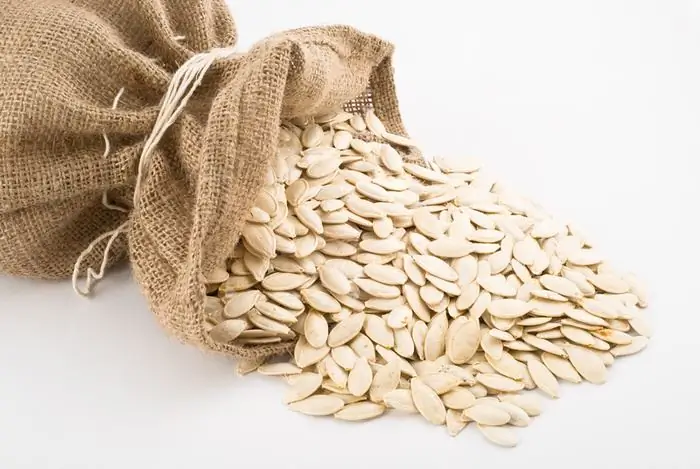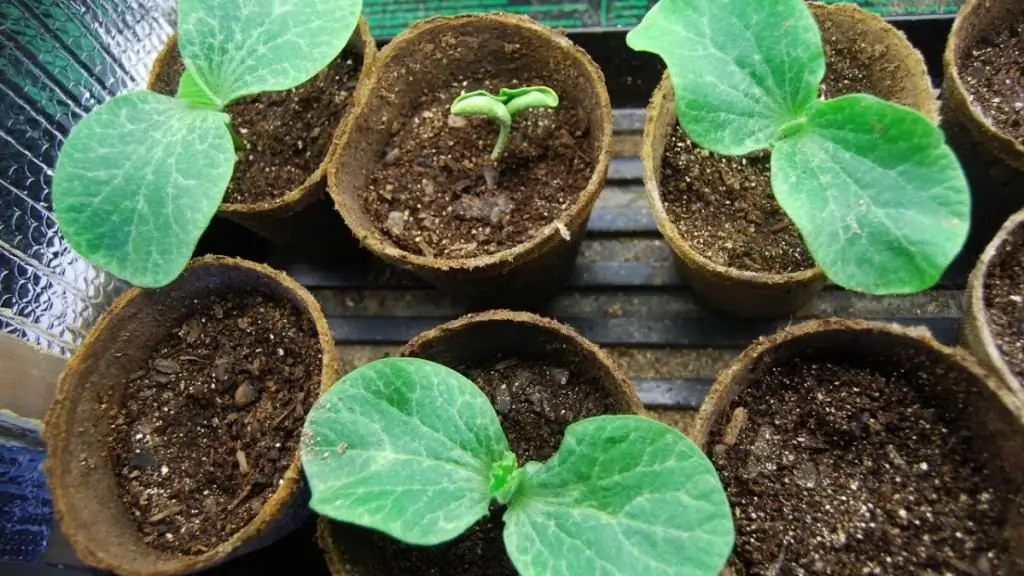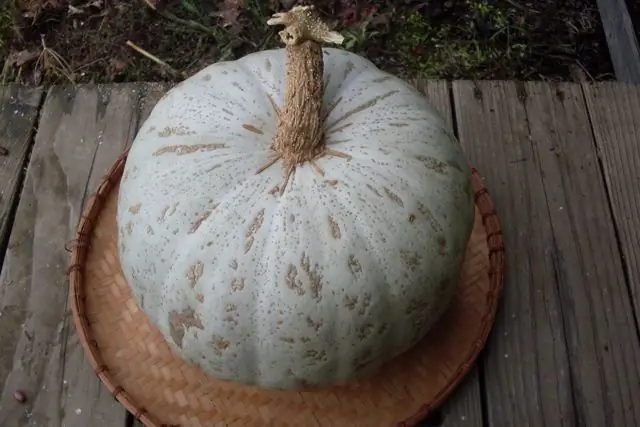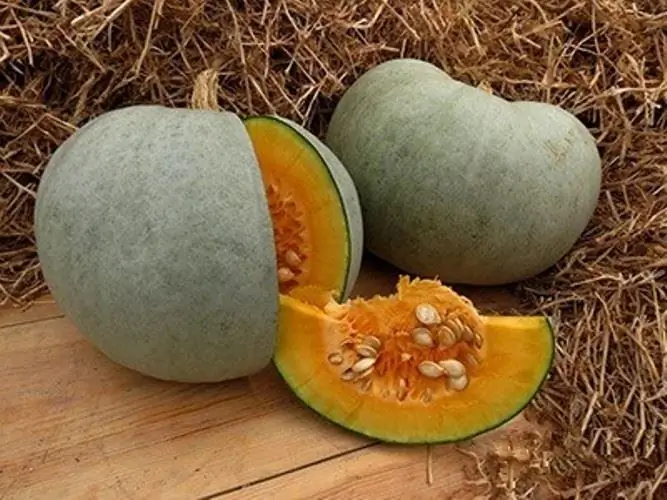The inhabitants of South America were the first to taste the pumpkin. In the future, this unpretentious vegetable gained popularity all over the world. In Central Asia, it is used to make dishes, and in India they make traps for monkeys. In Russia, it appeared in the sixteenth century. There is a huge variety of pumpkins, ranging from miniature to giant, they all have different shades - green, orange, gray, red. There are ribbed and smooth, oval and round, perennial and annual.
Pumpkin Volga gray: description
A variety of large-fruited pumpkin called Volga gray was bred in 1940. The plant is powerful with long lashes up to 8 m, has large kidney-shaped leaves and a petiole longer than a quarter of a meter. Flattened fruit weighing up to 9 kg with a smooth or slightly segmented surface. Elastic bark of a light gray or gray-green hue does not contain a pattern. Cream or yellow flesh, up to 4.5 cm thick, has a medium density and a good sweetish taste.

Insidethe fetus has a large seed nest with a medium-density placenta. Volga gray pumpkin belongs to mid-season varieties. It takes about 120 days from germination to fruit ripening. The yield, depending on the fertility of the soil, ranges from 1.8 to 3.5 kg per square meter. The plant tolerates dry weather conditions well, and the fruit has good transportability and keeping quality, and is used for table purposes. It is noted that the variety is relatively resistant to fruit rot, Fusarium wilt and powdery mildew.
Pumpkin planting
To get a rich harvest of Volga gray pumpkin, it matters:
- Choose a location - preferably a sunny location, sheltered from the wind. However, it can also ripen in partial shade.
- Soil type - careful preparation is required with the application of potash and phosphorus fertilizers, rotted manure, ash.
- Compliance with the rules of crop rotation - the largest seeds are selected. They are preliminarily disinfected, germinated and hardened for two days at a temperature of zero degrees.

- The seeding depth depends on the soil and ranges from four to seven centimeters. Holes are made after eighty centimeters, throwing two seeds into them.
- Feeding - fertilizer is applied three times, and to stimulate development several times a season they are sprayed with biological products.
- Care - shaping the plant, watering, loosening, removing weeds, powdering stems, and pollinating flowers.
Growing methodspumpkins
Sometimes a pumpkin is planted on the south side in a greenhouse, and when the lash reaches sixty centimeters, it is taken out into the street. Growing in this way allows you to get a crop much earlier. At the same time, other crops, such as cucumbers, can grow in the greenhouse. The pumpkin root system is located in the ground below the roots of cucumbers and does not interfere with them.
In addition, you can get an early harvest of gray Volga pumpkin, the photo of which is presented in the article, as follows. The bed after sowing seeds is covered with plastic wrap. When the first shoots appear, cuts are made in it so that the plant can throw the whip out through them. With this method, seedling losses are reduced.

However, the seedling method of growing vegetables is recognized as the most popular. The seeds are placed in peat containers filled with a light soil mixture consisting of lowland peat, humus, mullein and soddy soil, taken in a ratio of 5:3:1:1. For the growth of seedlings, good lighting and compliance with the temperature regime are required, at least 20 degrees during the day, and 15 degrees at night. By the time of planting, pumpkin seedlings should have a stocky stem with internodes and well-developed leaves. Planted together with a container so as not to damage the root system.
Feeding plants
To get large fruits, it is necessary to feed the Volga gray pumpkin several times a season:
- When 3-5 leaf plates appeared, mullein is used, one part of which is dissolved in a ten-liter bucket of water and watered. one bucketshould be enough for five plants.
- At the beginning of the formation of lashes, - as in the first case, use mullein and add nitrophoska (one tablespoon) to it.
- When fruits are formed, the same mullein is used, into which a glass of ash and two tablespoons of potassium sulfate are added, the plants are watered with the resulting solution.
Formation of the plant. Powdering stems
Volga gray pumpkin requires the correct formation of lashes. To do this, pinch the main stem. The best option is the formation of a plant in two stems. The whip is positioned so that the top is in the sun, otherwise the crop will be small. For growing especially large fruits, a plant is formed in one lash. On the main stem, after four leaves, one shoot is left on each side, and the rest are removed. Further, all shoots are removed when they appear.

As soon as the ovaries grow up to five centimeters, the he althiest ones are selected from them, and the rest are destroyed. Each shoot is pinched three leaves after the fruit. The next condition for a good harvest is the powdering of lashes. When they reach one meter, they are laid in the right direction and sprinkled with loose soil in several places. They will root fairly quickly, and the plant will receive additional nutrients.
Storage
Volga gray pumpkin is harvested when it reaches maturity, which can be easily identified by the corky stalk. The vegetable can be stored for a long period (about a year).

To do this, it is laid on dry straw and creates the appropriate conditions in a well-ventilated room: a temperature of about 6 degrees and an air humidity of about 70 percent. In the apartment, a ripe vegetable can be stored for up to five months.
Pumpkin Volga gray, reviews
Many summer residents grow pumpkins on their plots, including the Volga gray pumpkin, and share their tips and successes. Here are some of them:
- Growing pumpkin through seedlings, care was quite simple. The main thing is timely watering and top dressing, the vegetable has grown in weight of 20 kg.
- Some complain that the pumpkin did not have time to ripen and the fruits turned out to be small with thin and green flesh, not at all sweet.
- Others share recipes for various dishes. Assorted vegetables are prepared from unripe pumpkin fruits, adding onions, carrots, peppers and eggplants. Ripe pumpkin fruits are baked in the oven, sprinkled with sugar on top, fried with an egg in a pan, added to puree soup.
Conclusion
Large, good-tasting fruits of the Volga gray pumpkin, the description of the variety of which is given at the beginning of the article, are grown in the middle lane through seedlings.

After the end of frosts, they are planted in a permanent place in fertile and well-cultivated soil. The plant prefers sunny places with regular watering and top dressing. Pumpkin fruits are used both for pet food and successfully used in cooking to prepare various dishes.






